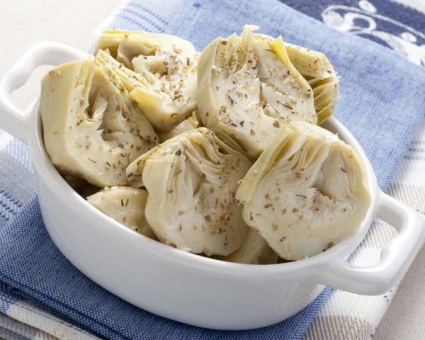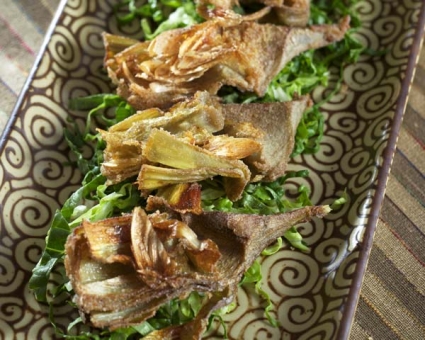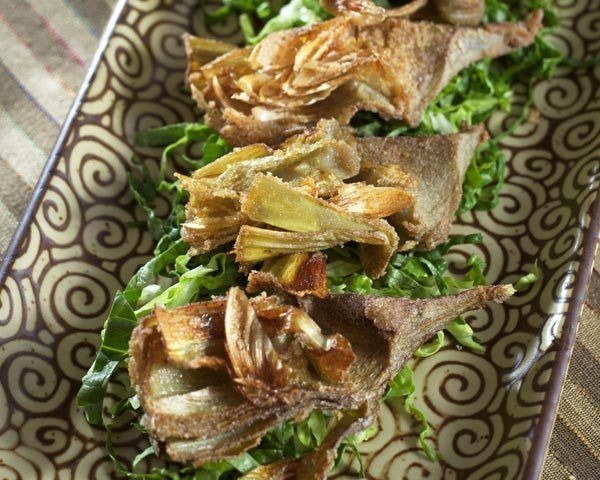To Turn Or Not To Turn An Artichoke?
To turn, or not to turn an artichoke... that is often the question — and it was one I frequently found myself asking last week while teaching cooking demos at Robin Leach's Food University at Caesars Palace in Las Vegas.
The demos' overarching theme was gourmet vegetables, and I worked with chef Bradford Thompson to put together a one-hour class that taught the students valuable information and techniques. Not only did we want to teach them a recipe, but we wanted them to walk away from the class feeling as if they had learned a lifelong skill, one that they could apply at any point in time in the kitchen and with any kind of food.
And then, of course, there were the vegetables. We chose to focus on artichokes, and we tied in other vegetables with the two recipes we chose to prepare. The first was Artichokes Barigoule, an old Provençal dish of braised, tender artichokes served in a flavorful sauce. The second was Fried Artichoke Hearts, served in a creamy and fresh pea pesto aioli. What both of these recipes required was the heart of the artichoke, trimmed of all of its tough outer leaves and its hairy choke, and so along with the recipes, we decided to teach the students how to turn an artichoke.
Click here to see the Artichokes Barigoule Recipe

It was the perfect demonstration for us to give — as Bradford spent most of the early days of his career in strict French kitchens under demanding French chefs such as Daniel Boulud, and Food University's co-host Claudine Pépin grew up with, according to many, the master of French cooking, Jacques Pépin, as her father.
To turn an artichoke is a skilled task — carefully trimming the stem of an artichoke and shaving away its outer leaves in a precise and careful manner so that the heart remains perfectly intact. The students watched Bradford skillfully turn an artichoke in a matter of seconds, observing and listening as he explained why it's called turning an artichoke and not trimming (because you literally turn the choke into the knife), and how you strategically decide where to start your cuts so that you complete your task without damaging the heart.
Click for the Fried Artichokes Recipe

As Bradford demonstrated, he explained that he considered turning an artichoke therapeutic because it took just the right amount of concentration to keep you focused but still allowed your mind to wander off to wherever it wanted to go. He also explained that if you were working in a French kitchen as he had, or if you had cooked with a talented French father as Claudine did, you would obsessively trim the artichoke until it was perfect, leaving no choke or imperfections behind. He encouraged our students to enjoy it just as he does, and to get the basic technique down without fretting over the tiny, hairy (excuse the pun) details.
Our students were eager to turn their own artichokes, and they immediately dove in when they returned to their stations. Their enthusiasm slowly deteriorated, though, as they began to turn and exclamations like "what do I do now?" and "ouch!" started to fill the classroom (we had only two cuts in all three demos, which was impressive). Frustration and feelings of defeat were thick in the air. When the hard part was over, we moved onto the recipes, braising some of the hearts in a citrus liquid so they were tender and flavorful, and frying the rest of them until crisp to serve with an indulgent aioli.
The chagrin of turning an artichoke practically disappeared when the recipes were finished, and the students enjoyed the beautiful dishes that we helped them prepare. The verdict was in: artichokes were delicious, and the recipes used to prepare them were gourmet and impressive. There was still that step of turning the artichokes, though, and as Claudine strolled the stations in our first demo, I heard her offering words of encouragement and relief by telling them that frozen artichoke hearts were just as tasty as fresh ones.
At the start of the second demo, I followed Claudine's lead, and began my instruction by telling the students that frozen artichoke hearts were available in most grocery stores and were an easy and simple solution to these recipes. I did the same for the third, and by the end of the day all of the students were convinced: the recipes were staying, but the manually turned artichokes were out.
So, would you turn your own artichokes? If you are like Bradford or Claudine, the answer might be yes, but maybe if you were only making a dish for two and had time to enjoy such therapeutic work, as Bradford put it. But at the heart of all cooking, it's about the end result and how it tastes, so I suggest you get there with as little irritation as possible.
Anne Dolce is the Cook editor at The Daily Meal. Follow her on Twitter @anniecdolce
